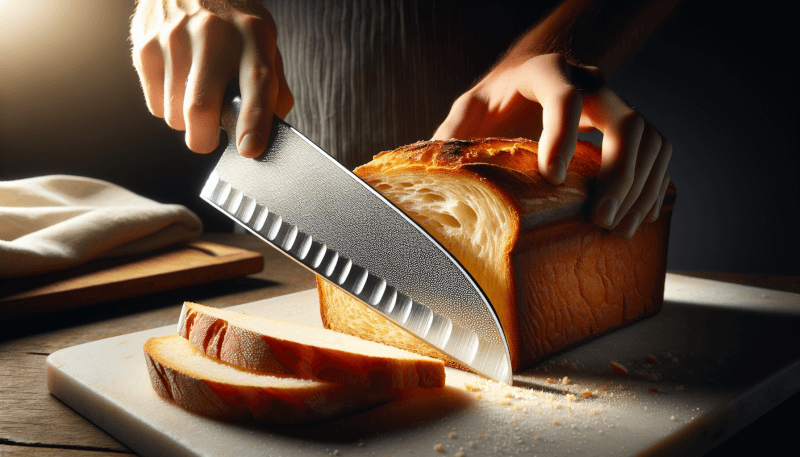Have you ever wondered what sets a bread knife apart from a slicing knife? The answer may surprise you! While they may share a similar purpose of cutting food, these two kitchen knives have distinct differences that make them suited for specific tasks. In this article, we will explore the unique characteristics of both a bread knife and a slicing knife, helping you understand when to reach for each one in your culinary endeavors. Let’s unravel the mystery and discover the secrets behind these essential kitchen tools!
Blade Shape
Bread Knife
A bread knife typically has a long, serrated blade with a pointed tip. This shape allows for effortless slicing through crusty bread without crushing it. The serrated edge of the blade helps to grip the crust, making it easier to make clean cuts through loaves of bread.
Slicing Knife
A slicing knife, on the other hand, usually has a long and narrow blade with a rounded tip. The shape of the blade is designed to make smooth, precise slices through various types of food, including meats, vegetables, and fruits. The rounded tip ensures that you can easily maneuver the knife for consistent and controlled slicing.
Blade Length
Bread Knife
Bread knives typically have longer blades compared to other types of knives. The longer blade allows you to slice through wider loaves of bread or cakes in a single motion, without having to saw back and forth. The standard blade length for a bread knife is usually around 8 to 10 inches.
Slicing Knife
Slicing knives come in a variety of blade lengths, ranging from 8 to 14 inches. The length of the blade depends on the specific purpose of the knife. For instance, a shorter blade of around 8 to 10 inches is ideal for slicing smaller cuts of meat or vegetables, while a longer blade of 12 to 14 inches is better suited for larger roasts or whole fish.

Blade Thickness
Bread Knife
Bread knives usually have thicker blades compared to slicing knives. The thickness of the blade helps to provide stability and support when cutting through hard-crusted breads, such as artisan loaves or baguettes. A thicker blade ensures that the knife can withstand the pressure applied during the slicing process without bending or flexing.
Slicing Knife
Slicing knives typically have thinner blades compared to bread knives. The thinness of the blade allows for more precise slicing, especially when it comes to delicate ingredients like thinly sliced meats or fish. The thinner blade reduces resistance, resulting in cleaner cuts and minimal tearing or shredding of the food.
Blade Flexibility
Bread Knife
Bread knives generally have little to no flexibility in their blades. This lack of flexibility ensures stability and control when slicing through loaves of bread with tough crusts. The stiff blade enables you to apply even pressure without the blade bending or wavering, resulting in clean and straight cuts.
Slicing Knife
Slicing knives, especially those designed for slicing meats, often have some flexibility in their blades. This flexibility allows the blade to move with the contours of the food being sliced, ensuring smooth and precise cuts. The slight flex in the blade also helps to reduce the chance of the knife getting stuck or dragged as you slice through larger cuts of meat.

Serrated or Plain Edge
Bread Knife
A bread knife always has a serrated edge. The serrations give the knife the ability to grip and cut through crusty or tough surfaces, such as the outer crust of a loaf of bread or the skin of a pineapple. The serrated edge ensures that you can make clean, effortless slices without crushing or squishing the food.
Slicing Knife
Slicing knives typically have a plain edge, meaning they are smooth and sharp without any serrations. The plain edge allows for precise and clean slicing, particularly for foods that have a tender or delicate texture. The absence of serrations ensures a smooth cutting motion through foods like meats, fruits, and vegetables.
Purpose
Bread Knife
The primary purpose of a bread knife is to slice through all types of bread without damaging the interior or squishing the loaf. The serrations on the blade provide the necessary grip and cutting action to effortlessly slice through crusty breads, bagels, pastries, or even cakes. A bread knife is a must-have tool for any bread lover or baker.
Slicing Knife
A slicing knife is designed for making precise, thin slices of various foods, including meats, vegetables, fruits, and even certain types of hard cheeses. Its long, narrow blade and sharp edge allow for smooth cuts without tearing or shredding the food. A slicing knife is a versatile tool that can be used in the kitchen for a wide range of slicing tasks.

Ideal Foods for each Knife
Bread Knife
A bread knife is perfect for slicing bread, whether it’s a crusty baguette, a soft ciabatta, or a dense sourdough loaf. The serrated edge of the bread knife cuts through the crust effortlessly while maintaining the integrity of the soft interior. It can also be used to slice pastries, cakes, or even tomatoes, where the serrations prevent the delicate skin from being crushed.
Slicing Knife
A slicing knife is ideal for slicing meats, such as roasts, hams, or turkey breasts, into thin and even slices. It can also be used to slice cooked poultry, fish, or larger vegetables with precision. The long, narrow blade allows for smooth gliding cuts, ensuring that each slice is uniform and consistent.
Technique
Bread Knife
When using a bread knife, it is best to use a sawing motion. Begin by placing the knife at the top of the loaf, gently saw back and forth while applying consistent downward pressure. This technique helps to maintain control and prevent the bread from getting squished or pushed down. Remember to use the full length of the blade and avoid using excessive force.
Slicing Knife
To achieve optimal results with a slicing knife, it is important to use a slicing or carving motion. Hold the knife at a slight angle and use long, smooth strokes to slice through the food. It is essential to maintain a steady and consistent pace to ensure even slices. To prevent the food from tearing, ensure that the knife is sharp and glide the blade through the food without applying too much pressure.

Blade Design
Bread Knife
The blade design of a bread knife typically consists of a combination of straight and curved serrated edges. This design ensures that the knife can penetrate tough crusts and glide smoothly through soft interiors without tearing or crushing the bread. The length of the serrations may vary, but they are always present to provide the necessary cutting action.
Slicing Knife
The blade design of a slicing knife is usually straight and smooth, without any serrations. The long, narrow blade allows for efficient slicing with minimal effort. Some slicing knives may feature a granton edge, which incorporates small hollowed-out sections along the length of the blade. The granton edge reduces friction, resulting in smoother and easier slicing.
Maintenance and Care
Bread Knife
To ensure the longevity and effectiveness of a bread knife, proper maintenance and care are essential. After each use, make sure to hand wash the knife with warm soapy water and dry it thoroughly. Avoid putting the bread knife in the dishwasher, as the harsh detergents and high temperatures can damage the blade. Additionally, regular sharpening of the serrations is recommended to maintain optimal cutting performance.
Slicing Knife
To keep a slicing knife in optimal condition, it is important to clean and maintain it properly. Hand wash the knife with mild soap and warm water, making sure to remove any food particles. Dry the knife thoroughly to prevent moisture buildup and potential corrosion. Regularly sharpen the blade using a sharpening stone or honing rod to maintain its sharpness and precision. Avoid using a slicing knife on hard surfaces or cutting through bones, as this can cause damage to the blade.
In conclusion, while both bread knives and slicing knives serve different purposes in the kitchen, they each excel in their respective areas. A bread knife is essential for effortlessly slicing through bread and pastries, while a slicing knife is perfect for precise slicing of meats, fruits, and vegetables. Understanding the differences in blade shape, length, thickness, flexibility, edge design, and purpose will help you choose the right knife for your specific needs. Remember to take proper care of your knives to ensure they remain sharp, efficient, and reliable for all your slicing tasks.



